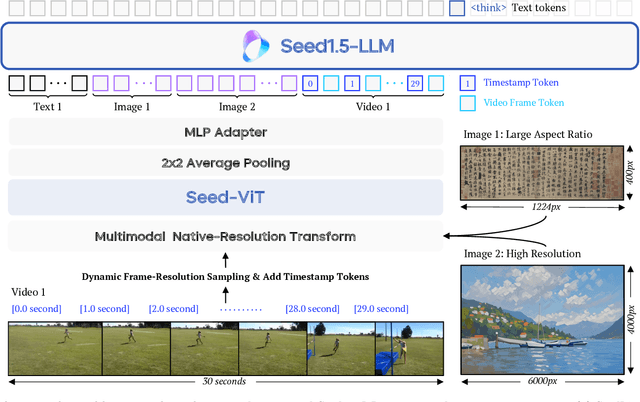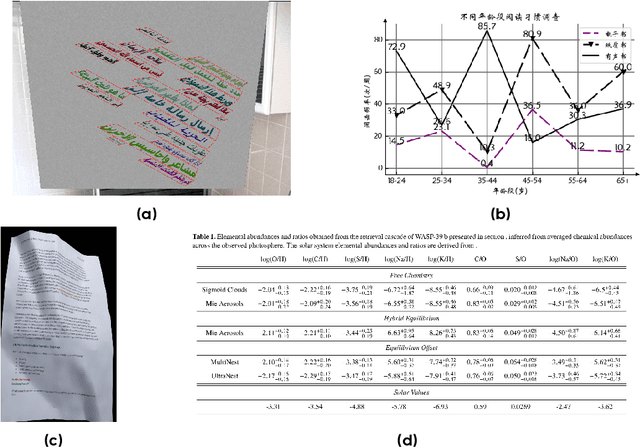Gang Wu
Atom: Efficient On-Device Video-Language Pipelines Through Modular Reuse
Dec 18, 2025Abstract:Recent advances in video-language models have enabled powerful applications like video retrieval, captioning, and assembly. However, executing such multi-stage pipelines efficiently on mobile devices remains challenging due to redundant model loads and fragmented execution. We introduce Atom, an on-device system that restructures video-language pipelines for fast and efficient execution. Atom decomposes a billion-parameter model into reusable modules, such as the visual encoder and language decoder, and reuses them across subtasks like captioning, reasoning, and indexing. This reuse-centric design eliminates repeated model loading and enables parallel execution, reducing end-to-end latency without sacrificing performance. On commodity smartphones, Atom achieves 27--33% faster execution compared to non-reuse baselines, with only marginal performance drop ($\leq$ 2.3 Recall@1 in retrieval, $\leq$ 1.5 CIDEr in captioning). These results position Atom as a practical, scalable approach for efficient video-language understanding on edge devices.
MedGEN-Bench: Contextually entangled benchmark for open-ended multimodal medical generation
Nov 18, 2025Abstract:As Vision-Language Models (VLMs) increasingly gain traction in medical applications, clinicians are progressively expecting AI systems not only to generate textual diagnoses but also to produce corresponding medical images that integrate seamlessly into authentic clinical workflows. Despite the growing interest, existing medical visual benchmarks present notable limitations. They often rely on ambiguous queries that lack sufficient relevance to image content, oversimplify complex diagnostic reasoning into closed-ended shortcuts, and adopt a text-centric evaluation paradigm that overlooks the importance of image generation capabilities. To address these challenges, we introduce MedGEN-Bench, a comprehensive multimodal benchmark designed to advance medical AI research. MedGEN-Bench comprises 6,422 expert-validated image-text pairs spanning six imaging modalities, 16 clinical tasks, and 28 subtasks. It is structured into three distinct formats: Visual Question Answering, Image Editing, and Contextual Multimodal Generation. What sets MedGEN-Bench apart is its focus on contextually intertwined instructions that necessitate sophisticated cross-modal reasoning and open-ended generative outputs, moving beyond the constraints of multiple-choice formats. To evaluate the performance of existing systems, we employ a novel three-tier assessment framework that integrates pixel-level metrics, semantic text analysis, and expert-guided clinical relevance scoring. Using this framework, we systematically assess 10 compositional frameworks, 3 unified models, and 5 VLMs.
Exploring the Global-to-Local Attention Scheme in Graph Transformers: An Empirical Study
Sep 18, 2025Abstract:Graph Transformers (GTs) show considerable potential in graph representation learning. The architecture of GTs typically integrates Graph Neural Networks (GNNs) with global attention mechanisms either in parallel or as a precursor to attention mechanisms, yielding a local-and-global or local-to-global attention scheme. However, as the global attention mechanism primarily captures long-range dependencies between nodes, these integration schemes may suffer from information loss, where the local neighborhood information learned by GNN could be diluted by the attention mechanism. Therefore, we propose G2LFormer, featuring a novel global-to-local attention scheme where the shallow network layers use attention mechanisms to capture global information, while the deeper layers employ GNN modules to learn local structural information, thereby preventing nodes from ignoring their immediate neighbors. An effective cross-layer information fusion strategy is introduced to allow local layers to retain beneficial information from global layers and alleviate information loss, with acceptable trade-offs in scalability. To validate the feasibility of the global-to-local attention scheme, we compare G2LFormer with state-of-the-art linear GTs and GNNs on node-level and graph-level tasks. The results indicate that G2LFormer exhibits excellent performance while keeping linear complexity.
A Survey on Long-Video Storytelling Generation: Architectures, Consistency, and Cinematic Quality
Jul 09, 2025

Abstract:Despite the significant progress that has been made in video generative models, existing state-of-the-art methods can only produce videos lasting 5-16 seconds, often labeled "long-form videos". Furthermore, videos exceeding 16 seconds struggle to maintain consistent character appearances and scene layouts throughout the narrative. In particular, multi-subject long videos still fail to preserve character consistency and motion coherence. While some methods can generate videos up to 150 seconds long, they often suffer from frame redundancy and low temporal diversity. Recent work has attempted to produce long-form videos featuring multiple characters, narrative coherence, and high-fidelity detail. We comprehensively studied 32 papers on video generation to identify key architectural components and training strategies that consistently yield these qualities. We also construct a comprehensive novel taxonomy of existing methods and present comparative tables that categorize papers by their architectural designs and performance characteristics.
Boosting All-in-One Image Restoration via Self-Improved Privilege Learning
May 30, 2025Abstract:Unified image restoration models for diverse and mixed degradations often suffer from unstable optimization dynamics and inter-task conflicts. This paper introduces Self-Improved Privilege Learning (SIPL), a novel paradigm that overcomes these limitations by innovatively extending the utility of privileged information (PI) beyond training into the inference stage. Unlike conventional Privilege Learning, where ground-truth-derived guidance is typically discarded after training, SIPL empowers the model to leverage its own preliminary outputs as pseudo-privileged signals for iterative self-refinement at test time. Central to SIPL is Proxy Fusion, a lightweight module incorporating a learnable Privileged Dictionary. During training, this dictionary distills essential high-frequency and structural priors from privileged feature representations. Critically, at inference, the same learned dictionary then interacts with features derived from the model's initial restoration, facilitating a self-correction loop. SIPL can be seamlessly integrated into various backbone architectures, offering substantial performance improvements with minimal computational overhead. Extensive experiments demonstrate that SIPL significantly advances the state-of-the-art on diverse all-in-one image restoration benchmarks. For instance, when integrated with the PromptIR model, SIPL achieves remarkable PSNR improvements of +4.58 dB on composite degradation tasks and +1.28 dB on diverse five-task benchmarks, underscoring its effectiveness and broad applicability. Codes are available at our project page https://github.com/Aitical/SIPL.
Exploring Generalized Gait Recognition: Reducing Redundancy and Noise within Indoor and Outdoor Datasets
May 21, 2025Abstract:Generalized gait recognition, which aims to achieve robust performance across diverse domains, remains a challenging problem due to severe domain shifts in viewpoints, appearances, and environments. While mixed-dataset training is widely used to enhance generalization, it introduces new obstacles including inter-dataset optimization conflicts and redundant or noisy samples, both of which hinder effective representation learning. To address these challenges, we propose a unified framework that systematically improves cross-domain gait recognition. First, we design a disentangled triplet loss that isolates supervision signals across datasets, mitigating gradient conflicts during optimization. Second, we introduce a targeted dataset distillation strategy that filters out the least informative 20\% of training samples based on feature redundancy and prediction uncertainty, enhancing data efficiency. Extensive experiments on CASIA-B, OU-MVLP, Gait3D, and GREW demonstrate that our method significantly improves cross-dataset recognition for both GaitBase and DeepGaitV2 backbones, without sacrificing source-domain accuracy. Code will be released at https://github.com/li1er3/Generalized_Gait.
Seed1.5-VL Technical Report
May 11, 2025



Abstract:We present Seed1.5-VL, a vision-language foundation model designed to advance general-purpose multimodal understanding and reasoning. Seed1.5-VL is composed with a 532M-parameter vision encoder and a Mixture-of-Experts (MoE) LLM of 20B active parameters. Despite its relatively compact architecture, it delivers strong performance across a wide spectrum of public VLM benchmarks and internal evaluation suites, achieving the state-of-the-art performance on 38 out of 60 public benchmarks. Moreover, in agent-centric tasks such as GUI control and gameplay, Seed1.5-VL outperforms leading multimodal systems, including OpenAI CUA and Claude 3.7. Beyond visual and video understanding, it also demonstrates strong reasoning abilities, making it particularly effective for multimodal reasoning challenges such as visual puzzles. We believe these capabilities will empower broader applications across diverse tasks. In this report, we mainly provide a comprehensive review of our experiences in building Seed1.5-VL across model design, data construction, and training at various stages, hoping that this report can inspire further research. Seed1.5-VL is now accessible at https://www.volcengine.com/ (Volcano Engine Model ID: doubao-1-5-thinking-vision-pro-250428)
Skill Discovery for Software Scripting Automation via Offline Simulations with LLMs
Apr 29, 2025Abstract:Scripting interfaces enable users to automate tasks and customize software workflows, but creating scripts traditionally requires programming expertise and familiarity with specific APIs, posing barriers for many users. While Large Language Models (LLMs) can generate code from natural language queries, runtime code generation is severely limited due to unverified code, security risks, longer response times, and higher computational costs. To bridge the gap, we propose an offline simulation framework to curate a software-specific skillset, a collection of verified scripts, by exploiting LLMs and publicly available scripting guides. Our framework comprises two components: (1) task creation, using top-down functionality guidance and bottom-up API synergy exploration to generate helpful tasks; and (2) skill generation with trials, refining and validating scripts based on execution feedback. To efficiently navigate the extensive API landscape, we introduce a Graph Neural Network (GNN)-based link prediction model to capture API synergy, enabling the generation of skills involving underutilized APIs and expanding the skillset's diversity. Experiments with Adobe Illustrator demonstrate that our framework significantly improves automation success rates, reduces response time, and saves runtime token costs compared to traditional runtime code generation. This is the first attempt to use software scripting interfaces as a testbed for LLM-based systems, highlighting the advantages of leveraging execution feedback in a controlled environment and offering valuable insights into aligning AI capabilities with user needs in specialized software domains.
GraphicBench: A Planning Benchmark for Graphic Design with Language Agents
Apr 15, 2025Abstract:Large Language Model (LLM)-powered agents have unlocked new possibilities for automating human tasks. While prior work has focused on well-defined tasks with specified goals, the capabilities of agents in creative design tasks with open-ended goals remain underexplored. We introduce GraphicBench, a new planning benchmark for graphic design that covers 1,079 user queries and input images across four design types. We further present GraphicTown, an LLM agent framework with three design experts and 46 actions (tools) to choose from for executing each step of the planned workflows in web environments. Experiments with six LLMs demonstrate their ability to generate workflows that integrate both explicit design constraints from user queries and implicit commonsense constraints. However, these workflows often do not lead to successful execution outcomes, primarily due to challenges in: (1) reasoning about spatial relationships, (2) coordinating global dependencies across experts, and (3) retrieving the most appropriate action per step. We envision GraphicBench as a challenging yet valuable testbed for advancing LLM-agent planning and execution in creative design tasks.
Beyond Degradation Redundancy: Contrastive Prompt Learning for All-in-One Image Restoration
Apr 14, 2025



Abstract:All-in-one image restoration, addressing diverse degradation types with a unified model, presents significant challenges in designing task-specific prompts that effectively guide restoration across multiple degradation scenarios. While adaptive prompt learning enables end-to-end optimization, it often yields overlapping or redundant task representations. Conversely, explicit prompts derived from pretrained classifiers enhance discriminability but may discard critical visual information for reconstruction. To address these limitations, we introduce Contrastive Prompt Learning (CPL), a novel framework that fundamentally enhances prompt-task alignment through two complementary innovations: a \emph{Sparse Prompt Module (SPM)} that efficiently captures degradation-specific features while minimizing redundancy, and a \emph{Contrastive Prompt Regularization (CPR)} that explicitly strengthens task boundaries by incorporating negative prompt samples across different degradation types. Unlike previous approaches that focus primarily on degradation classification, CPL optimizes the critical interaction between prompts and the restoration model itself. Extensive experiments across five comprehensive benchmarks demonstrate that CPL consistently enhances state-of-the-art all-in-one restoration models, achieving significant improvements in both standard multi-task scenarios and challenging composite degradation settings. Our framework establishes new state-of-the-art performance while maintaining parameter efficiency, offering a principled solution for unified image restoration.
 Add to Chrome
Add to Chrome Add to Firefox
Add to Firefox Add to Edge
Add to Edge